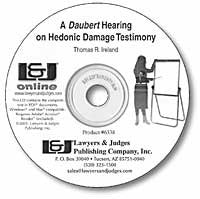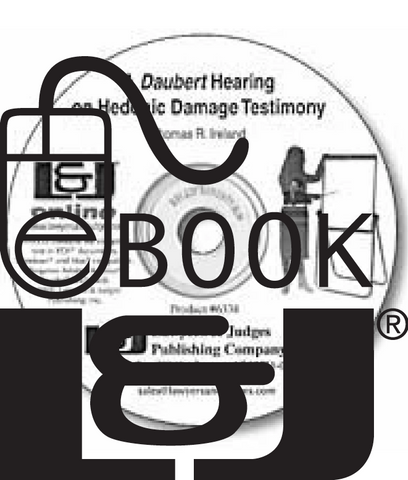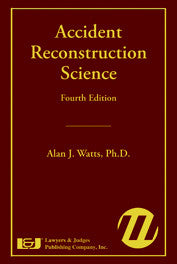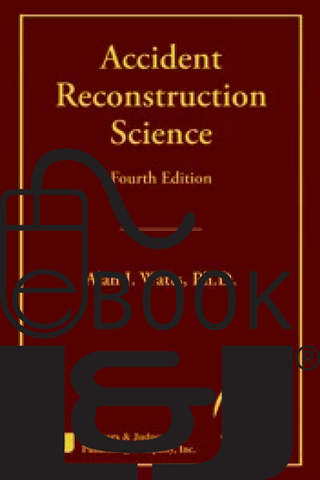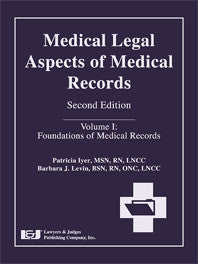
Medical Legal Aspects of Medical Records, Second Edition (Volume I)
- Author: Patricia W. Iyer, Barbara J. Levin
- ISBN 10: 1-933264-79-9
- ISBN 13: 978-1-933264-79-0
- Copyright Date Ed: February 1, 2010
- Pages: 416 pages
- Binding Information: Casebound
- Size: 8.5 ✕ 11 Inches (US)
Medical Legal Aspects of Medical Records, Second Edition is the reference of choice for cases involving medical records and their use. The book has been divided into two volumes for ease of finding the information you need. Both volumes have been updated to give you the latest information, as recent changes in legislation and technology have changed the medical records process. The authors have designed this work to give extensive information on the HIPPA policies, standards initiatives, legal use of records, billing and coding, and computerization of records and record keeping systems and how they apply in forensic situations.
Use Volume I to get a comprehensive overview of the medical records process. In any health care situation, records are made, and each situation presents its own unique aspects and challenges. This book explores the many aspects of medical records that apply across all specialties. It is specially designed to complement Volume II.
Use Volume II for in-depth information on many clinical specialties. This book informs you of the specific nature of clinical specialty records and hospital areas of specialty are covered, including chapters on dental, chiropractic, nursing home, pediatrics, medication, and home care. It is specially designed to complement Volume I.
Used jointly, these two Volumes are a powerful tool for your practice and are exceptionally valuable to all those in the legal profession or in law enforcement who deal with medical records on a regular basis.
This book is also available as an eBook. Click here to purchase and download:
Topics Include:
- Complementary and alternative medicine
- Dental records
- Home care records
- Independent medical examination
- Office-based medical records
- Ophthalmology records
- Emergency medical services records
- Emergency department records
- Critical care records
- Diagnostic testing
- Intravenous therapy records
- Long-term care records
- Medical surgical records
- Medication records
- The nursing process and nursing records
- Obstetrical records
- Orthopedic records
- Pain assessment and management
- Pediatric records
- Perioperative records
- Physician documentation
- Psychiatric records
- Physical therapy records
- Rehabilitation records
- Respiratory care records
- Skin trauma
- Medical terminology and abbreviations
- Internet resources
- Textbook references
- Glossary
- And more!
Use Volume I to get a comprehensive overview of the medical records process. In any health care situation, records are made, and each situation presents its own unique aspects and challenges. This book explores the many aspects of medical records that apply across all specialties.
It is specially designed to complement Volume II. Used jointly, these two Volumes are a powerful tool for your practice and are exceptionally valuable to all those in the legal profession or in law enforcement who deal with medical records on a regular basis.
Table of Contents
Chapter 1: Generating and Preserving Medical Records
Cynthia L. Northcutt, BSN, RN, JD and Mary Ann Shea, JD, BS, RN
1.1 Introduction
1.2 Definition and Purposes of the Medical Record
1.3 HIPAA and Medical Records: Administrative Simplification, Privacy, and Confidentiality
1.4 Privacy and Confidentiality
1.5 The Field of Health Information Management
1.6 Ownership of the Medical Record
1.7 Standards of Record-Keeping and Patient
1.8 Retention of Medical Records
1.9 Storage and Destruction of Old Medical Records
1.10 Additional or Supplemental Medical Records that May Exist Outside the Main Chart
1.11 Summary
Chapter 2: Legal Aspects of Charting
Patricia Iyer, MSN, RN, LNCC
2.1 Introduction
2.2 Timing of Charting
2.3 Format of Charting
2.4 Content of Charting
2.5 Summary
Chapter 3 : Obtaining and Organizing Medical Records
Patricia Iyer, MSN, RN, LNCC and Jane Barone, BS, RN, LNCC
3.1 Introduction
3.2 Who Asks for the Records
3.3 What Records to Obtain
3.4 When to Ask for Records
3.5 How to Request Records and Other Information
3.6 Initial Intake of Records
3.7 Ensuring Records are Complete
3.8 Organizing Hospital Records
3.9 Organizing Rehabilitation Facility Records
3.10 Organizing Nursing Home Records
3.11 Organizing Physician Office Records
3.12 Organizing Ambulatory Care Records
3.13 Deciphering Records
3.14 Handling of Records
3.15 Summary
Chapter 4 : Analyzing Medical Records
Marguerite Barbacci, BSN, RNC, LNCC, and Patricia Iyer, MSN, RN, LNCC
4.1 Introduction
4.2 Indexing
4.3 Analysis of Medical Records
4.4 Review of Personal Injury Records
4.5 Summary
Chapter 5: Charting Systems
Patricia Iyer, MSN, RN, LNCC
5.1 Introduction
5.2 Source-Oriented Charting
5.3 Narrative Charting
5.4 Problem-Oriented Charting (SOAP)
5.5 PIE Charting
5.6 Focus Charting(r)
5.7 Charting by Exception
5.8 FACT Charting
5.9 Summary
Chapter 6 : Computerized Medical Records
Patricia Iyer, MSN, RN, LNCC and Hilary Flanders, MPH, RN-BC, RRT
6.1 Introduction
6.2 The Paper Chart
6.3 Use of Computers to Prepare Medical Records
6.4 Definitions of Computerized Medical Records
6.5 Status of Computerized Medical Records
6.6 Advantages and Disadvantages of Computerized Records
6.7 Bedside Terminals
6.8 Barriers to the Introduction of Nursing Information Systems
6.9 Implementation Challenges
6.10 Summary
Chapter 7 : Preparing for E-discovery of Electronic Medical Record Information
G. Ann Geyer, Esq.
7.1 Introduction
7.2 The New E-discovery Rules
7.3 Managing E-discovery of EMR Information
7.4 Summary
Chapter 8 : Billing and Coding
Agnes Grogan, BS, RN
8.1 Introduction
8.2 Value of Bill Review in Legal Setting
8.3 Basics of Medical Billing
8.4 Codes
8.5 Coding Responsibilities
8.6 Resources
8.7 Generation of Bills
8.8 Fraudulent Billing
8.9 Miscellaneous Issues
8.10 Summary
Chapter 9 : Health Insurance Portability and Accountability Act (HIPAA)
Marilyn Frank-Stromborg, EdD, JD, FAAN, Kenneth Burns, RN, PhD, Bob Morgan, Esq., and Desirée Bromme Sierens, BA
9.1 Introduction
9.2 History of HIPAA
9.3 Who is Regulated by HIPAA?
9.4 How HIPAA Impacts Medical, Nursing, and Legal Arenas
9.5 Frequently Asked Questions About HIPAA
9.6 The Effect of HIPAA on Healthcare Providers and Law Firms
9.7 Privacy Issues
9.8 HIPAA Case Study
9.9 The Next Phase: Security Rules, Transaction and Code Set Standards, and Identifier Standards
9.10 Conclusion
Chapter 10 : Patient Safety Initiatives and Medical Records
Patricia Iyer, MSN, RN, LNCC and Susan Mellott, RN, CPHQ, FNAHQ, PhD
10.1 Introduction
10.2 The Current Healthcare Environment
10.3 The Joint Commission
10.4 The Joint Commission Survey Process
10.5 National Patient Safety Goals
10.6 NPSG.01: Improve the Accuracy of Patient Identification
10.7 NPSG.02: Improve the Effectiveness of Communication Among Caregivers
10.8 NPSG.03: Improve the Safety of Using Medications
10.9 NPSG.04: Eliminate Wrong-Site, Wrong-Patient, Wrong-Procedure Surgery
10.10 NPSG.05: Improve the Safety of Using Infusion Pumps: Ensure Free Flow Protection
10.11 NPSG.06: Improve the Effectiveness of Clinical Alarm Systems
10.12 NPSG.07: Reduce the Risk of Healthcare-Acquired Infections
10.13 NPSG.08: Accurately and Completely Reconcile Medications Across the Continuum of Care
10.14 NPSG.09: Reduce the Risk of Patient Harm Resulting From Falls
10.15 NPSG.10: Reduce the Risk of Influenza and Pneumococcal Disease in Older Adults
10.16 NPSG.11: Reduce the Risk of Surgical Fires
10.17 NPSG.12: Implementation of Applicable National Patient Safety Goals and Associated Requirements by Components and Practitioner Sites
10.18 NPSG.13: Encourage the Active Involvement of Patients and Their Families in the Patient's Care as a Patient Safety Strategy
10.19 NPSG.14: Prevent Healthcare-Associated Pressure Ulcers (Decubitus Ulcers)
10.20 NPSG.15: The Organization Identifies the Safety Risks Inherent in its Patient Population
10.21 NPSG.16: Improve Recognition and Response to Changes in a Patient's Condition
10.22 Universal Protocol
10.23 The Leapfrog Group
10.24 National Quality Forum
10.25 Institute for Healthcare Improvement Initiatives
10.26 Summary
Chapter 11: Presuit Use of Medical Records
Leilani Kicklighter, MBA, RN, ARM, DFASHRM, CPHRM, LHRM
11.1 Introduction
11.2 Incident Reports and Reporting to Risk Management
11.3 Confidentiality of Incident Reports
11.4 Regulatory Standards
11.5 Sequestering Records
11.6 The Record Is What the Record Is
11.7 Potentially Compensable Events (PCEs)
11.8 Expert Witnesses
11.9 References
11.10 Reviewing the Medical Record
11.11 Insurance Carrier's Involvement
11.12 Summary
Chapter 12 : Attorney Use of Personal Injury Medical Records
Jeffrey I. Zimmerman, Esq.
12.1 Introduction
12.2 Are the Relevant Records Complete?
12.3 History of Injury
12.4 Use of Medical Records
12.5 Analysis of Medical Records
12.6 Communicating with the Physician
12.7 Battle of the Titans, or How to Play David to the Insurance Carrier's Goliath
12.8 Summary
Chapter 13 : Attorney Use of Medical Records in a Medical Malpractice Case
Peter I. Bergé, Esq., P.A.
13.1 Introduction
13.2 The Role Of Medical Records in Evaluating Medical Malpractice Claims
13.3 Pitfalls in Obtaining Medical Records
13.4 Preparing to File Suit
13.5 Use of Records After Suit is Filed
13.6 Use of Records at Deposition
13.7 Use of Records at Trial
13.8 Summary
Chapter 14: Preventing Healthcare-Acquired Conditions Means Never Having to Say You're Sorry
Carol Ann Armenti, MA, JD
14.1 Introduction
14.2 The Healthcare Climate Begs Change
14.3 Financial Climate Motivates
14.4 Payment Implications
14.5 DRA Revisited
14.6 Unintended Consequences
14.7 Documentation Implications
14.8 Summary
Chapter 15 : Tampering with Medical Records
Roy Konray, Esq. and Patricia Iyer, MSN, RN, LNCC
15.1 Introduction
15.2 Substandard Charting
15.3 Suspicious Charting
15.4 Definitions of Spoliation
15.5 Spoliation Inference
15.6 Implications of Spoliation
15.7 Organizing Medical Records
15.8 Techniques for Tampering with Medical Records
15.9 Detection of Tampering
15.10 Strategic Decisions
15.11 Defense of Spoliation Claims
15.12 Summary
Chapter 16: Forensic Examination of Medical Records
A. Frank Hicks, DABFDE
16.1 Introduction
16.2 What Is a Forensic Document Examiner and How Is One Located?
16.3 How Can a Forensic Document Examiner Assist the Attorney?
16.4 The Importance of Knowing the Charting Habits of the Medical Personnel
16.5 Summary
Chapter 17: Forensic Medical Records
Virginia A. Lynch, MSN, RN, FAAN and Jamie Ferrell, BSN, RN, DABFN, CA/CP-SANE, SANE-A, CMI-III, CFN
17.1 Introduction
17.2 Definitions of Forensic Nursing
17.3 Forensic Professionals
17.4 Location and Provision of Forensic Services
17.5 Common Forensic Issues
17.6 Trauma Quality Management (TQM) and Forensic Cases
17.7 Principles of Forensic Documentation
17.8 What Is Forensic Evidence?
17.9 Commonly Occurring Forensic Circumstances Requiring Evidence Recovery
17.10 Bite Marks
17.11 Gunshot Wounds
17.12 Forensic Toxicology
17.13 Sexual Assault
17.14 Ethical Issues and Legal Precedents
17.15 Summary
Chapter 18 : Autopsy Reports
Cyril H. Wecht, MD, JD, Steven A. Koehler, MPH, PhD, and Lone Thanning, MD
18.1 Introduction
18.2 Death Investigation System Developmen
18.3 The Death Investigation Systems in Modern America
18.4 The Stages of Death
18.5 Pronouncing and Criteria for Reporting a Death
18.6 The Death Investigation Team
18.7 The Forensic Pathologist
18.8 Types of Autopsies
18.9 Exhumation of a Body
18.10 Key Components of the Forensic Reports
18.11 Definition: Medical-Legal
18.12 Summary

